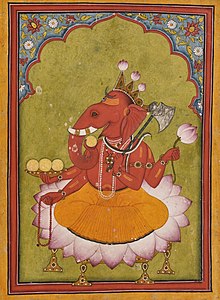गणेश
Appearance
| Ganesha | |
|---|---|
 | |
| दूसर नाँव | Vinayaka, Ganapati |
| देवनागरी | गणेशः |
| संस्कृत ट्रांसलिटरेशन | Gaṇeśa |
| संबंधित बाड़े | Deva , Brahman (Ganapatya) , Panchayatana puja |
| धाम | Mount Kailash (with parents Shiva and Parvati) |
| मंत्र | Oṃ Shri Gaṇeśāya Namaḥ Oṃ Gaṃ Gaṇapataye Namaḥ |
| हथियार | Paraśu (axe), pāśa (noose), aṅkuśa (elephant goad) |
| चीन्हा | OM, Modak |
| वाहन | Mouse |
| ग्रंथ | Ganesha Purana, Mudgala Purana, Ganapati Atharvashirsa |
| लिंग | Male |
| तिहुआर | Ganesh Chaturthi |
| Personal information | |
| Consort | |
| माई-बाबूजी | |
| सहोदर | Kartikeya (brother) |
गणेश एगो हिंदू देवता हवें जिनके धड़ आदमी नियर आ सिर हाथी के कल्पित कइल जाला। हिंदू कथा अनुसार ई भगवान शिव आ पार्वती के छोट बेटा हवें।
इनके सवारी मूस मानल जालें आ ई शिव जी के सगरी गण सभ के मुखिया हवें।
भगवान गणेश भगवान शिव औरी माता पार्वती के सबसे छोट पुत्र हउवन।भगवान गणेश के पत्नी का नाम रिद्धि औरी सिद्धि ह। रिद्धि औरी सिद्धि भगवान विश्वकर्मा की पुत्रि हइ लोगीन। भगवन गणेश के नाम हिन्दू धर्म में कवनो भी शुभ कार्य करने से पहीले लिहाल जाला।
संदर्भ
[संपादन करीं]- ↑ Heras 1972, p. 58.
- ↑ Getty 1936, p. 5.
- ↑ "Ganesha getting ready to throw his lotus. Basohli miniature, circa 1730. National Museum, New Delhi. In the Mudgalapurāṇa (VII, 70), in order to kill the demon of egotism (Mamāsura) who had attacked him, Gaṇeśa Vighnarāja throws his lotus at him. Unable to bear the fragrance of the divine flower, the demon surrenders to Gaṇeśha." For quotation of description of the work, see: Martin-Dubost (1997), p. 73.
| ई हिंदू कथा लेख एगो आधार बाटे। जानकारी जोड़ के एकरा के बढ़ावे में विकिपीडिया के मदद करीं। |
